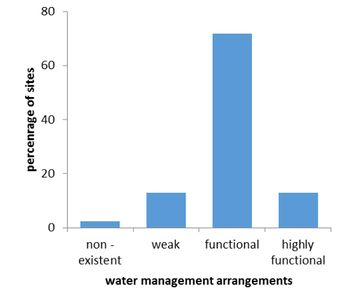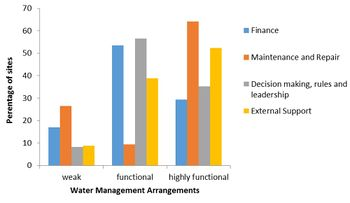OR/17/024 Water management arrangements
| Kebede, S, MacDonald, A M, Bonsor, H C, Dessie, N, Yehualaeshet, T, Wolde, G, Wilson, P, Whaley, L, and Lark, R M. 2017. UPGro Hidden Crisis Research Consortium — Survey 1 Country Report–Uganda . British Geological Survey Internal Report, OR/17/024. |
 |
During Survey 1 in Ethiopia a social survey of the village-level water management arrangements was also carried out at each water point. A core aspect of the social-science component of the Hidden Crisis project is to not assume that all local management functions are performed solely by the formally appointed water point committee. Instead, the focus of the research has been broadened to include all local actors and institutions who may play a part in managing HPBs. This is why we use the term water management arrangement (WMA), which includes the water point committee but is not limited to it.
The project developed a definition of a WMA (see Appendix 2 – A functioning water management arrangement). This definition lists 8 different attributes that need to be present to a greater or lesser extent if the WMA is to be considered ‘functioning’. A structured social survey was designed with a total of 23 questions that addressed the 8 attributes of a WMA, where each question could be ranked between 1 (lowest) and 3 (highest). The survey was divided into 4 categories of questions: (1) Finance; (2) Maintenance and Repair; (3) Decision making, rules, and leadership; and (4) External Support. The quality of the Water Management Arrangements was then assessed by placing each into 4 categories depending on total score.
| Scores | Functionality of WMA |
| Scores mostly 1s | Non existent |
| Scores 1s and 2s | Weak |
| Scores mostly 2s and 3s | Functional |
| Scores mainly 3s | Highly Functional |


The survey indicates the vast majority of the Water Management Arrangements (85%) are functional or highly functional, but also indicates some differences in the different aspects of governance arrangements. Note the small bimodal distribution with Maintenance and Repair and the slightly lower scores for Finance and Decision making rules and leadership.
Initial exploration of the data show no simple relationship between the physical functionality and water management arrangements although more sophisticated analysis is yet to be undertaken. These initial findings are consistent with the hypothesis that the relationship between WMAs and HPBs is complex and multifaceted. These complexities and inter-relationships are being investigated in more detail within the second project survey.